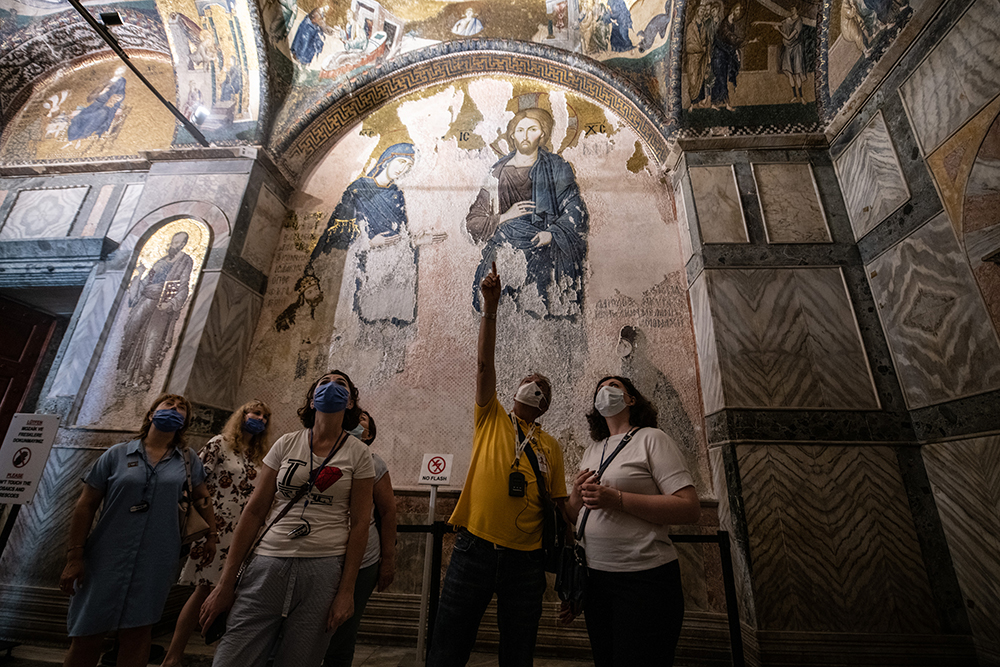
by Engy Magdy, Special to The Tablet
CAIRO — Istanbul’s Chora Church, famed for nearly 17 centuries for elaborate mosaics and frescoes depicting the life stories of Jesus and Mary, will be reopened as a mosque as Turkish President Recep Tayyip Erdogan moves forward with plans to convert iconic Byzantine churches into mosques.
Turkey’s state-run news agency reported that restoration work at the Chora site is being completed, and authorities are working to open it for worship in May.
Originally constructed in the fourth century, the Chora Church served as a Christian church until the 15th century. Subsequently, it was converted into a mosque in 1511, following the conquest of Istanbul by the Ottomans.
Under secular Turkey, it has been functioning as a museum since 1945. It is one of the most significant Byzantine landmarks in the world, a status that Erdogan seeks to dismantle.
Chora is the second church to be converted to a mosque. The first was the iconic cathedral Hagia Sophia, which for a millennium was the seat of the ecumenical patriarch of the Eastern Orthodox church, until it was converted into a mosque under Ottoman rule in the 15th century.
Both churches are UNESCO World Heritage Sites, which were reopened as museums under Kemal Ataturk, the first president of modern Turkey.
Erdogan’s decision to turn churches back into mosques comes as no surprise, as he has consistently expressed his desire to return historic churches to their previous status as mosques, a stance that plays well with his political base.
“Political Islam in Turkey always had the wish to open such churches to Muslim worshippers one day,” said a Turkish journalist who talked to The Tablet on condition of anonymity because of safety concerns. “Considering this political movement in this country … it is not a coincidence to make Hagia Sophia or Chora a mosque again.”
“For Erdogan, the politics here are irresistible. It is hard to imagine a more powerful image of Islamification than to see him leading prayers in a building converted from an Orthodox Christian church into a mosque in 1453 by Ottoman Sultan Mehmed II after his conquest of Constantinople,” Mustafa Akyol, a senior fellow at the Cato Institute wrote previously.
From Erdogan’s vantage point, it would be a huge symbolic step toward bolstering his policy of religious nationalism.
“But for many others, including Turkey’s tiny Christian minority and millions of other Christians around the world, it will be a disturbing echo of the bloody conquests of the Middle Ages — not the peaceful coexistence most people aspire to in the modern world,” Akyol added in an article co-written with Richard V. Reeves, a senior fellow at the Brookings Institution.
Chora Church, also known as the Church of the Holy Savior, was built as part of a monastery complex outside the city walls of Constantinople. It was rebuilt in the 11th century to take the form of an inscribed cross, and underwent restoration between the 12th and 14th centuries after it suffered a partial collapse, perhaps due to an earthquake.
According to the UNESCO digital library, the church’s mosaics and frescoes, commissioned by the Byzantine Greek statesman and poet Theodore Metochites, form one of the most complete ensembles of late Byzantine art to survive in Istanbul.
In the outer narthex of the church, the Virgin Mary is depicted with Jesus still in her womb, reflecting the mythical meaning that Chora has for many visitors, which is that it represents the womb of Mary.
A mosaic of Christ Pantocrator decorates its ceiling, a typical depiction of Christ as an all-powerful ruler who holds the New Testament in one hand while holding out the other to give a blessing. In the inner narthex, there are two large domes, one depicting the genealogy of the Virgin Mary and one with the genealogy of Christ.
When the Ottomans conquered the city in 1453, Chora Church was one of the first churches to be looted. Some 50 years later, the church was converted into a mosque under Sultan Bayezid II.
The mosque was called Kariye Camii, and a mihrab, minbar, and minaret were added to the structure. The word “Kariye” is the Turkish term for the neighborhood, according to Harvard University’s Department of History of Art and Architecture.
The Byzantine Chora Church was supposed to be opened to Muslim worshippers for Friday prayers last February, based on a presidential decree, but the plan was delayed to next May.
Erdogan’s plan to convert the church into a mosque sparked an outcry in Greece and among Greek communities. Greek President Katerina Sakellaropoulou called the decision “an act of symbolic violence dictated by political arrogance.”
She further called it an act of “cultural insecurity and religious intolerance, which condemns a treasure trove of Christian art and cultural nobility to obscurity.”
Rev. Gabriel, Metropolitan of Nea Ionia and Philadelphia, told The Tablet the issue “is a very important issue of religious violations and respect of religious rights.”
In the United States, the advocacy group Hellenic American Leadership Council launched a letter asking the U.S. Commission on International Religious Freedom to publicly condemn Turkey’s decision and recommend that the U.S. exercise all diplomatic and political influence to prevent the conversion of Chora Church.
Although Erdogan’s decisions were applauded by some people in the Middle East, others warned of the consequences.
“The extremists understand this step as being in favor of Islam, and a clear victory, but they are ignorant that it contradicts the interest of Islam and Muslims,” Iraqi writer Rasheed Al-Khayoun wrote in his op-ed in the Saudi newspaper Asharq Al-Awsat.
“The interest today is in the dialogue between people, and at the forefront comes the dialogue of religions, especially after the terrorism that we have seen [from] extremist groups.”
